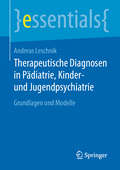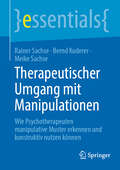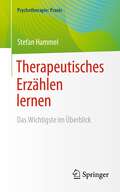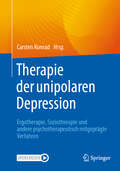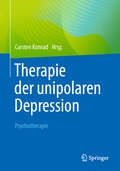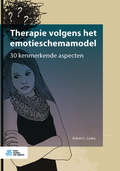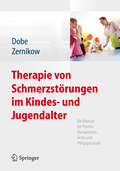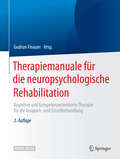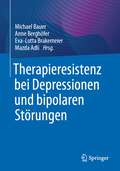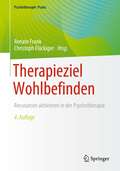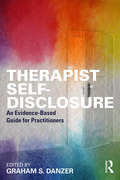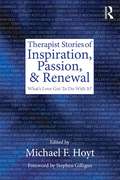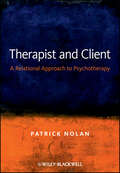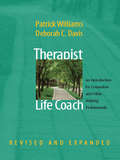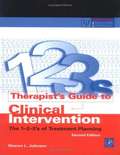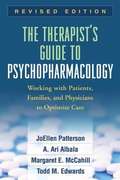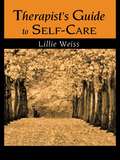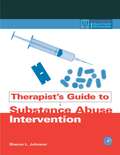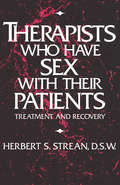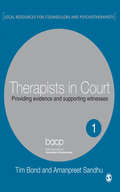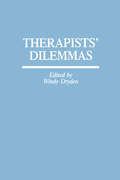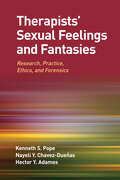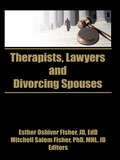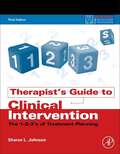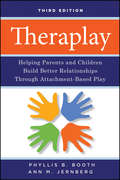- Table View
- List View
Therapeutische Diagnosen in Pädiatrie, Kinder- und Jugendpsychiatrie: Grundlagen und Modelle (essentials)
by Andreas LeschnikIn Deutschland haben wir zwei Klassifikationsmodelle, um Kinder mit Problemen und Ressourcen ganzheitlich zu erfassen. Zum einen die ICD-10 (International Statistical Classification of Diseases and Related Health Problems 10. Revision) und zum anderen die ICF-CY (International Classification of Functioning, Disability and Health. Children and Youth Version). In der Vergangenheit hat sich aber gezeigt, dass die ICD-10 und die ICF-CY nicht in Kombination miteinander benutzt werden. Somit entsteht automatisch eine nicht vollständige Diagnostik. Beide Klassifikationsmodelle wurden aber so entwickelt, dass sie aufeinander abgestimmt sind und sich somit ergänzen. Allerdings haben diese Model keine Leitlinie, wann und wo man sie in einem Prozess zum Erstellen einer therapeutischen Diagnose einsetzt. Dieses Buch soll aufzeigen, welche Modelle man benötigt, um eine therapeutische Diagnose zu erstellen.
Therapeutischer Umgang mit Manipulationen: Wie Psychotherapeuten manipulative Muster erkennen und konstruktiv nutzen können (essentials)
by Rainer Sachse Bernd Kuderer Meike SachseIn diesem essential erfahren Psychotherapeuten, Psychosomatische Mediziner, Psychiater, Berater, wie Klientinnen und Klienten mit sogenannten Persönlichkeitsakzentuierungen oder Persönlichkeitsstörungen versuchen, die Therapeutinnen und Therapeuten im Therapie-Prozess zu manipulieren. Dies erzeugt für Therapeuten schwierige Interaktionssituationen. Das Buch beschreibt, wie Therapeuten solche Manipulationen erkennen und wie sie damit konstruktiv umgehen können.
Therapeutisches Erzählen lernen: Das Wichtigste im Überblick (Psychotherapie: Praxis)
by Stefan HammelDas Buch gibt eine hypnosystemisch fundierte Einführung in das therapeutische Erzählen in Medizin, Kindertherapie und Erwachsenenpsychotherapie, Paartherapie, Familientherapie, Sozialarbeit, Seelsorge, Pädagogik, Coaching, Supervision und verwandten Berufsfeldern. Aus dem Inhalt: Was Geschichtenerzählen mit Therapie zu tun hat. Warum, wann und wie Geschichten therapeutisch wirken. Wo ich therapeutische Geschichten einsetzen kann. Wie ich die rechte Geschichte zur rechten Zeit finde. Wie ich eine therapeutische Geschichte strukturiere. Wie ich anfange und wie ich weitermache. Wie ich meine erzählerischen Fähigkeiten erweitere. Über den Autor: Stefan Hammel arbeitet als systemischer Therapeut, Hypnotherapeut und Autor, als evangelischer Klinik- und Psychiatrieseelsorger sowie als Leiter des Instituts für Hypnosystemische Beratung in Kaiserslautern und als Referent systemischer und hypnotherapeutischer Ausbildungsinstitute in Deutschland, Österreich und in der Schweiz. Er hält Seminare zu Erickson'scher Hypnotherapie, therapeutischem Erzählen, systemischer und hypnosystemischer Beratung. Arbeitsschwerpunkte liegen in den Bereichen Paar- und Familientherapie, Kinder- und Jugendlichentherapie, Depression, Angst, Trauma, Sterbe- und Trauerbegleitung sowie der Unterstützung somatischer Heilung.
Therapie der unipolaren Depression - Ergotherapie, Soziotherapie und andere psychotherapeutisch mitgeprägte Verfahren
by Carsten KonradDieses Buch stellt die gängigen psychotherapeutisch mitgeprägten Behandlungsverfahren vor, manchmal auch Kotherapien oder Fachtherapien genannt, die in der Behandlung der unipolaren Depression zur Anwendung kommen können: Es bietet einen praxisnahen Überblick über Therapiemöglichkeiten wie Sport- und Bewegungstherapie, Ergotherapie, Musiktherapie, Genesungsbegleitung und Recovery, tiergestützte Therapie, Therapieangebote durch die psychiatrische Fachpflege, Soziotherapie sowie das erfolgreiche Angehörigengespräch. Jedes Kapitel beginnt mit der Schilderung eines typischen Falls, der im Verlauf des Kapitels wie ein roter Faden fortgesetzt wird, um die im Kapitel dargestellten Interventionen jeweils praxisnah zu illustrieren. Jede Intervention wird in einzelne Handlungsschritte unterteilt, die in Modulen dargestellt werden, und mit Online-Materialien wie Arbeitsblättern, Informationsmaterialien, Aufklärungsbögen etc. unterlegt. Dabei folgen die Kapitel dem Prinzip der praxisnahen Beschreibung der einzelnen Methoden, die das Lesen einzelner Kapitel ohne den Zusammenhang mit den anderen Kapiteln ermöglicht. Das Buch ist die Fortführung und Aktualisierung der Sektion „Praxis der psychosozialen Therapien&“ in Konrad, C.: „Therapie der Depression – Praxisbuch der Behandlungsmethoden&“, Springer 2017. Es richtet sich einerseits an psychotherapeutisch tätige Ärzt:innen und Psycholog:innen, die sich einen Überblick über Einsatz und Möglichkeiten dieser Therapieverfahren verschaffen möchten. Andererseits ist es auch für interessierte Ergotherapeut:innen, Physiotherapeut:innen Gesundheits- und Krankenpfleger:innen, Genesungsbegleiter:innen, Soziotherapeut:innen oder Mitarbeiter:innen der Sozialdienste interessant, die hier in kompakter Form konkrete Anregungen und Anleitungen für die Behandlung ihrer Patient:innen erhalten.
Therapie der unipolaren Depression - Psychotherapie
by Carsten KonradDieses Buch stellt die gängigen psychotherapeutischen Verfahren dar, die in der Behandlung der unipolaren Depression eingesetzt werden können.Jedes Kapitel widmet sich der Darstellung eines für die Depressionsbehandlung geeigneten Psychotherapieverfahrens. Jedes Kapitel wird von der Schilderung eines typischen Falls durchzogen, an dem die einzelnen Interventionen im Therapieverlauf illustriert werden. Die Psychotherapieverfahren werden in einzelne Handlungsschritte (Module) unterteilt und mit Online-Materialien wie Arbeitsblätter, Informationsmaterialien, Aufklärungsbögen etc. unterlegt. Ziel des Buches ist es, eine praxisnahe Anleitung zu den verschiedenen Psychotherapieverfahren zu geben. Das Lesen einzelner Kapitel ohne den Zusammenhang mit den anderen Kapiteln ist möglich.Das Buch stellt die Fortführung und Aktualisierung der Psychotherapie-Sektion in Konrad, C.: Therapie der Depression – Praxisbuch der Behandlungsmethoden, Springer 2017, dar und richtetsich in erster Linie an psychotherapeutisch tätige Ärzt:innen und Psycholog:innen, die sich für eine moderne psychotherapeutische Behandlung der Depression interessieren.
Therapie volgens het emotieschemamodel: 30 kenmerkende aspecten
by Robert L. LeahyDit boek helpt zorgprofessionals bij de behandeling van cliënten met complexe emoties. Met het beschreven emotieschemamodel krijgen cliënten inzicht in hun emotieschema’s en leren ze ermee om te gaan. Het boek is bedoeld voor psychotherapeuten, psychiaters, psychologen en andere hulpverleners die zich willen verdiepen in emoties en emotieregulatie. Therapie volgens het emotieschemamodel: 30 kenmerkende aspecten beschrijft een nieuw model en biedt nieuwe inzichten over de manier waarop we denken over emoties, hoe we emoties waarderen en hoe we ermee omgaan. Hiervoor combineert de auteur zijn praktijkervaring met theorieën over cognitie, metacognitie en compassie. U leest hoe cliënten manieren kunnen ontwikkelen om met hun emoties om te gaan en deze te accepteren. Daarbij wordt onder andere ingegaan op emotieregulatiestrategieën, persoonlijk empowerment en interpersoonlijke emotieschema’s. De theorie in het boek wordt verduidelijkt met voorbeelden uit de praktijk. De instrumenten die aangereikt worden, zijn direct te gebruiken binnen bestaande behandelingen. Het boek is bondig geschreven en in compacte vorm uitgegeven. Hierdoor is het ideaal om als naslagwerk te gebruiken. Dr. Robert L. Leahy is onderzoeker en heeft jarenlange klinische ervaring. Hij is directeur van het American Institute for Cognitive Therapy in New York en is als Clinical Professor of Psychology, verbonden aan het Department of Psychiatry van Weill Cornell Medical College.
Therapie von Schmerzstörungen im Kindes- und Jugendalter
by Michael Dobe Boris ZernikowCa. 300.000 Kinder- und Jugendliche sind in Deutschland von chronischen Schmerzen betroffen, fehlen damit in der Schule und sind in ihrem sozialen Leben stark benachteiligt. Gezielt helfen kann nur der jenige, der sich mit dem Krankheitsbild, der notwendigen Diagnostik und Therapie ausreichend auskennt. Das Buch stellt das erprobte stationäre Schmerztherapieprogramm des Deutschen Kinderschmerzzentrums (DKSZ) an der Vestischen Kinder- und Jugenklinik in Datteln - Universität Witten/Herdecke vor. Es zeigt die professionelle Behandlung und den Umgang mit schmerzkranken Kindern und Jugendlichen auf: · Fachwissen, um die Ursache von chronischem Schmerz zu verstehen · Erfolgreiche Behandlungsmöglichkeiten basierend auf langjähriger, klinischer Erfahrung · Tages- und Therapiestruktur, Interventionen des Pflege- und Erziehungsteams (PET) und anderer beteiligter Berufsgruppen · Plus: Arbeitsmaterialien zur Erhebung von Ressourcen und besonderen Belastungsfaktoren Ambulante und stationäre Einrichtungen können mit dem Konzept eine wirksame stationäre Schmerztherapie für Kinder mit einer Schmerzstörung anbieten. Für ambulant tätige Psychotherapeuten, Pädiater und Schmerztherapeuten, die gezielt und konkret einen Überblick über Therapiemöglichkeiten und Inteventionen schmerzkranker Kinder und deren Familien suchen.
Therapiemanuale für die neuropsychologische Rehabilitation: Kognitive und kompetenzorientierte Therapie für die Gruppen- und Einzelbehandlung
by Gudrun FinauerHandbuch und Therapiematerialien (Übungsbögen, Protokollbögen usw.) für die (kosteneffiziente) Gruppenarbeit und Einzeltherapien mit Reha-Patienten nach Hirnschädigungen. Genaue Arbeitsanleitungen und umfassender Materialfundus für Planung und Ausführung klar strukturierter, wissenschaftlich evaluierter und praktisch erprobter Gruppenangebote zur Therapie kognitiver Hirnleistungen und Kompensation von Störungen. Die Arbeitsanleitungen beinhalten: Ablauf der Therapiestunden mit präzisen Zeitvorgaben, Beschreibung des jeweiligen Hauptthemas und relevanter Unterthemen, dazu jeweils Übungsblätter und „Hausaufgaben", Tipps bei Problemen im Gruppenprozess. Für erfahrene ebenso wie unerfahrene Therapeuten, die mit den Therapiemanualen selbstständig effiziente Gruppenangebote planen und durchführen können. NEU in der 2. Auflage: Lösungsvorschläge zu allen Übungen des Schwerpunkts „Exekutive Funktionen" (Kap. 4).
Therapieresistenz bei Depressionen und bipolaren Störungen
by Michael Bauer Anne Berghöfer Mazda Adli Eva-Lotta BrakemeierTherapieresistente depressive und bipolare Störungen stellen ungebrochen eine klinische Herausforderung dar: Therapeutisches Nichtansprechen bzw. Therapieresistenz depressiver und bipolarer Erkrankungen sind nicht nur häufig, sie erfordern oft auch eine stationäre Behandlung. Für Betroffene und Angehörige bedeutet das erhebliche Einschränkungen der Lebensqualität und der sozialen und beruflichen Funktionsfähigkeit. Therapieresistente Verläufe verursachen gleichzeitig sehr hohe Behandlungskosten.Um dieser Herausforderung zu begegnen, steht heute ein breites Spektrum pharmakologischer, psychotherapeutischer und psychosozialer Behandlungsmöglichkeiten zur Verfügung, das spezielle Kenntnisse und Erfahrungen voraussetzt. In diesem Buch stellen daher namhafte ExpertInnen in kurzen, prägnanten Kapiteln wissenschaftlich fundiert und mit hohem Praxisbezug den aktuellen Wissensstand dar und bieten Leitlinien für die Behandlung in Klinik und Praxis.Dabei werden auch neue Methoden, wie weiterentwickelte Hirnstimulationsverfahren, Chancen und Grenzen pharmakogenetischer Methoden zur präziseren Therapieempfehlung („bedside genotyping“), neue psychotherapeutische und pharmakologische Ansätze sowie innovative integrierte Versorgungsformen berücksichtigt. Das Buch richtet sich an PsychiaterInnen, NervenärztInnen, PsychotherapeutInnen und PsychologInnen, insbesondere im stationären Setting, aber auch in spezialisierten Praxen, sowie WissenschaftlerInnen von Forschungseinrichtungen und Industrieunternehmen.
Therapieziel Wohlbefinden: Ressourcen aktivieren in der Psychotherapie (Psychotherapie: Praxis)
by Renate Frank Christoph FlückigerDieses Buch stellt Psychotherapieansätze vor, die sich spezifisch auf Wohlbefinden, menschliche Stärken und seelische Gesundheit konzentrieren, u. a. ressourcenorientierte Psychotherapie, euthyme Therapie, Well-Being-Therapie, Mindfulness Based Therapy sowie narrative und Sinn fördernde Ansätze. Positive Psychologie und Wohlbefindensforschung finden immer mehr Beachtung: Was sind die Auswirkungen von Wohlbefinden, positiven Gefühlen, Zufriedenheit, konstruktiven Gedanken und eigenen Stärken? Wie begünstigen diese auch angesichts von Stress und Lebensbeeinträchtigungen ein erfülltes, produktives Leben? Und: Wie lässt sich Wohlbefinden im Rahmen einer Psychotherapie ganz direkt fördern? Geschrieben für ... Psychologische und Ärztliche Psychotherapeuten, Kinder- und Jugendlichenpsychotherapeuten, Psychiater, Klinische Psychologen. Über die Herausgeber:innen: Dr. Renate Frank, promovierte Psychologin und Psychotherapeutin. Sie leitete die verhaltenstherapeutische Ambulanz der Universität Gießen; ihre Arbeits- und Forschungsschwerpunkte: Wohlbefinden und Lebensqualität. Prof. Dr. phil. Christoph Flückiger, Psychotherapeut und Supervisor, Leiter der Spezialpraxis für Generalisierte Angststörungen Universität Zürich; seine Forschungs- und Lehrinteressen: Erforschung allgemeiner Wirkfaktoren in der Psychotherapie und in psychologischen Interventionen.
Therapist Self-Disclosure: An Evidence-Based Guide for Practitioners
by Graham S. DanzerTherapist Self-Disclosure gives clinicians professional and practical guidance on how and when to self-disclose in therapy. Chapters weave together theory, research, case studies, and applications to examine types of self-disclosure, timing, factors and dynamics of the therapeutic relationship, ethics in practice, and cultural, demographic, and vulnerability factors. Chapter authors then examine self-disclosure with specific client populations, including clients who are LGBTQ, Christian, multicultural, suffering from eating disorders or trauma, in forensic settings, at risk for suicide, with an intellectual disability, or are in recovery for substance abuse.This book will very helpful to graduate students, early career practitioners, and more seasoned professionals who have wrestled with decisions about whether to self-disclose under various clinical circumstances.
Therapist Stories of Inspiration, Passion, and Renewal: What's Love Got To Do With It?
by Edited by Michael F. HoytWhy do you practice psychotherapy? In this exciting volume, some of the field’s leading therapists tell true stories which evoke the pleasures, joys, and satisfactions that inspire passion for therapeutic work. Rather than focusing on the stresses and strains of being a clinician, these dramatic, poignant, wise, sometimes humorous and always soulful stories will help you gain (or regain) hope and excitement, and ultimately inspire a recommitment to a profession that, at its heart and soul, is about helping people.
Therapist and Client
by Patrick NolanTherapist and Client: A Relational Approach to Psychotherapy provides a guide to the fundamental interpersonal elements of the therapeutic relationship that make it the most effective factor in therapy.Presents the fundamental interpersonal elements that make the therapeutic relationship the most effective factor in psychotherapyExplores and integrates a range of approaches from various schools, from psychoanalysis to body-oriented psychotherapy and humanistic psychotherapiesOffers clear and practical explanations of the intersubjective aspects of therapyDemonstrates the pivotal need to work in the present moment in order to effect change and tailor therapy to the clientProvides detailed case studies and numerous practical applications of infant research and the unified body-mind perspective increasingly revealed by neuroscience
Therapist as Life Coach: An Introduction for Counselors and Other Helping Professionals (Revised and Expanded)
by Patrick Williams Deborah C. DavisIn 2006, U.S. News and World Report listed coaching as one of the 10 top growing professions. The first edition of Therapist as Life Coach, published in 2002, anticipated this trend, and since its publication it has become a standard for therapists who wish to transition or expand their practices into life coaching. Pat Williams and Deborah C. Davis have finally revised their classic practice-building book for today's therapists and future coaches. Every chapter in this second edition has been updated and rewritten, reflecting the growth of the coaching field and its increasing appeal to not only therapists, but all helping professionals. The book begins by exploring the history of the coaching movement and shows how society is hungry for life coaches. The second part of the book explains in detail the differences and similarities between coaching and therapy, discusses the coaching relationship, and considers some of the skills therapists will need to learn and unlearn in order to reclaim their joyfulness about their work. Professional transition tools such as developing and marketing your practice and honing your coaching skills are discussed at length in Part Three. The final section moves beyond basic life coaching to introduce coaching specialties such as corporate coaching, offers self-care strategies for life coaches, and peeks into the future of life coaching. There is new material throughout, including an overview of recent coaching developments, updated liability concerns, new business opportunities, and a new section on the research about coaching. Coaching gives practitioners the opportunity to break free of managed care and excessive reliance on the insurance industry and to work with a wide range of clients--specifically, those who are not suffering from mental illness but, rather, seeking to maximize their life potential. This book will help you enter this lucrative and personally enriching world with the skills and knowledge you need to build a successful coaching practice.
Therapist's Guide to Clinical Intervention: The 1-2-3's of Treatment Planning (2nd edition)
by Sharon L. JohnsonA must-have reference for clinicians completing insurance forms, participating in managed care, or practicing in treatment settings requiring formalized goals and treatment objectives. This practical, hands-on handbook outlines treatment goals and objectives for each type of psychopathology as defined by the diagnostic and statistical manual by the American Psychiatric Association, identifies skill-building resources, and provides samples of all major professional forms.
Therapist's Guide to Psychopharmacology, Revised Edition
by Joellen Patterson A. Ari AlbalaThis indispensable book provides therapists and counselors with crucial knowledge about psychotropic medications when and how to make medication referrals, how to answer patients' questions and help them handle problems that arise, and how to combine medication and psychotherapy effectively. Ideal for readers without extensive background in neurobiology, the book clearly explains how medications work in the brain and how they affect an individual's emotions, behavior, and relationships. Strategies for collaborating successfully with patients, their family members, and prescribers are discussed in detail. In this edition, psychopharmacology content has been fully updated.
Therapist's Guide to Self-Care
by Lillie WeissPsychotherapy is an increasingly stressful profession. Yet therapists spend most of their time helping clients deal with their stress, not caring for their own. This book is designed as a tool for the experienced counselor, junior therapist, and graduate student, as the issues confronted and discussed herein are relevant to anyone in the field, regardless of experience or expertise. Dr. Weiss has written a book in an easy, conversational tone, filled with concrete examples and blending research findings, clinical experience and theoretical approaches into practical suggestions and sound advice. The book is divided into three parts, discussing therapist concerns and questions that are continually raised, and providing practical tools based on clinical experience and research findings. It will be useful to all mental health professionals who have felt the strain of their practice.
Therapist's Guide to Substance Abuse Intervention
by Sharon L. JohnsonAuthor of AP's bestselling "Therapist's Guide to Clinical Intervention" now turns her attention to substance abuse intervention. The book will follow a similar format to her previous book, presenting information in easy to read outline form, with relevant forms, patient questionnaires, checklists, business documents, etc. Part I discusses the social impact of substance abuse and provides a general overview of the physiological and psychological characteristics of abuse, DSM IV definition of abuse, and classifications of the varying types of drugs. Part II is the main section of the book and covers assessment, different stages of abuse/recovery, and treatment choices. Coverage includes the discussion of myriad self-help choices (e.g. AA), group therapy, brief therapy, and more. Discussion will also include making a determination of treatment as inpatient or outpatient, and issues relevant to special populations (teenagers, geriatrics, comorbidity patients, etc.). Part III presents skill building resources. Part IV covers prevention, quality assurance, and also includes a glossary. The book, Outlines treatment goals and objectives, Outlines for assessing special circumstances, offers skill building resources to supplement treatment.
Therapists Who Have Sex With Their Patients: Treatment And Recovery
by Herbert S. StreanFirst published in 1994. Routledge is an imprint of Taylor & Francis, an informa company.
Therapists in Court: Providing Evidence and Supporting Witnesses (Legal Resources Counsellors & Psychotherapists #Vol. 1)
by Tim Bond Amanpreet SandhuTherapists in Court is the first in a series of handbooks providing legal guidance for practitioners from all the talking therapies, including counseling, psychotherapy and psychology. It is written for practitioners who come into contact with the legal system through their work. Providing practical guidance backed up with illuminating examples, the book is an invaluable source of information in situations such as responding to a solicitor's letter, supporting a witness in their preparation to appear in court, and being called as a witness.
Therapists' Dilemmas
by Windy DrydenThis book attempts to re-create a kind of informal atmosphere where therapists would feel relaxed enough to discuss their dilemmas in public and presents them in an interview format. It is designed for those who are prepared to be personally confronted by the issues raised in the interviews.
Therapists' Sexual Feelings and Fantasies: Research, Practice, Ethics, and Forensics
by Kenneth S. Pope Hector Y. Adames Nayeli Y. Chavez-DueñasThis book offers a concise, practical guide to ethical and legal concerns related to therapists' sexual feelings and fantasies. The psychotherapy profession has always struggled to deal openly with therapists' sexual feelings. Between the often unavoidable fact of sexual attraction, and the potential crossing of boundaries and sexual relationships with clients, there exists a wide range of assumptions, beliefs, feelings, and daydreams that often are suppressed and unspoken—sometimes with devastating consequences. This candid, practical book addresses three distinct areas related to therapists&’ sexual feelings: sexual attractions to clients (including sexual fantasies, dreams, and arousal); the violation of sexual boundaries with clients (including consensual therapist-patient sexual involvement); and forensic issues, including therapists who testify in cases where therapist-patient sex is at issue. The authors offer an extensive review of widespread and changing approaches to this topic in the history of psychotherapy, alongside a comprehensive look at current standards and research findings. They also provide important information for fact and expert witnesses, examining the evolving ethical and legal standards surrounding sexual relationships between therapists and clients, and discuss how to respond to clients to report having been sexually involved with a prior therapist. Incisive reflection questions encourage readers to recognize and respond appropriately to their own feelings in the therapy room.
Therapists, Lawyers, and Divorcing Spouses
by William FisherExperts explore the need for cooperation between the law and helping professions in order to lessen the trauma of the divorce process.
Therapist’s Guide to Clinical Intervention: The 1-2-3's of Treatment Planning
by Sharon L. JohnsonTherapist’s Guide to Clinical Intervention, Third Edition, is an essential reference for providing clinical services and associated case formulations requiring formalized goals and objectives. It is ideal for use in assessment, treatment, consultation, completing insurance forms, and/or participating in managed care. This practical, hand-on book, outlines treatment goals and objectives for each type of psychopathology as defined by the diagnostic and statistical manual by the American Psychiatric Association. It additionally provides skill-building resources and samples of all major professional forms likely to be used in clinical treatment. The third edition conveniently maps individualized treatment plans utilizing evidence-based best practices and standards of care. Diagnostic information is presented by associated disorder or theme for easier access. New special assessments and skill-building entries are included. Also new are numerous website/URLs associated with research articles, and consumer resources have been provided to complement clinical information and patient education. Outlines treatment goals and objectives for DSM-IV diagnoses Presents evidence-based best practices of intervention Provides the basis for assessing special circumstances Offers skill building resources to supplement treatment Contains samples for a wide range of business and clinical forms Supplies websites for additional clinical information and patient education
Theraplay
by Booth Phyllis B. Jernberg Ann M.Theraplay?a pioneering application of attachment theory to clinical work--helps parents learn and practice how to provide the playful engagement, empathic responsiveness, and clear guidance that lead to secure attachment and lifelong mental health in their children. This third edition of the groundbreaking book Theraplay shows how to use play to engage children in interactions that lead to competence, self-regulation, self-esteem, and trust. Theraplay's relationship-based approach is uniquely designed to help families facing today's busy and often chaotic lifestyle challenges form joyful, loving relationships.
